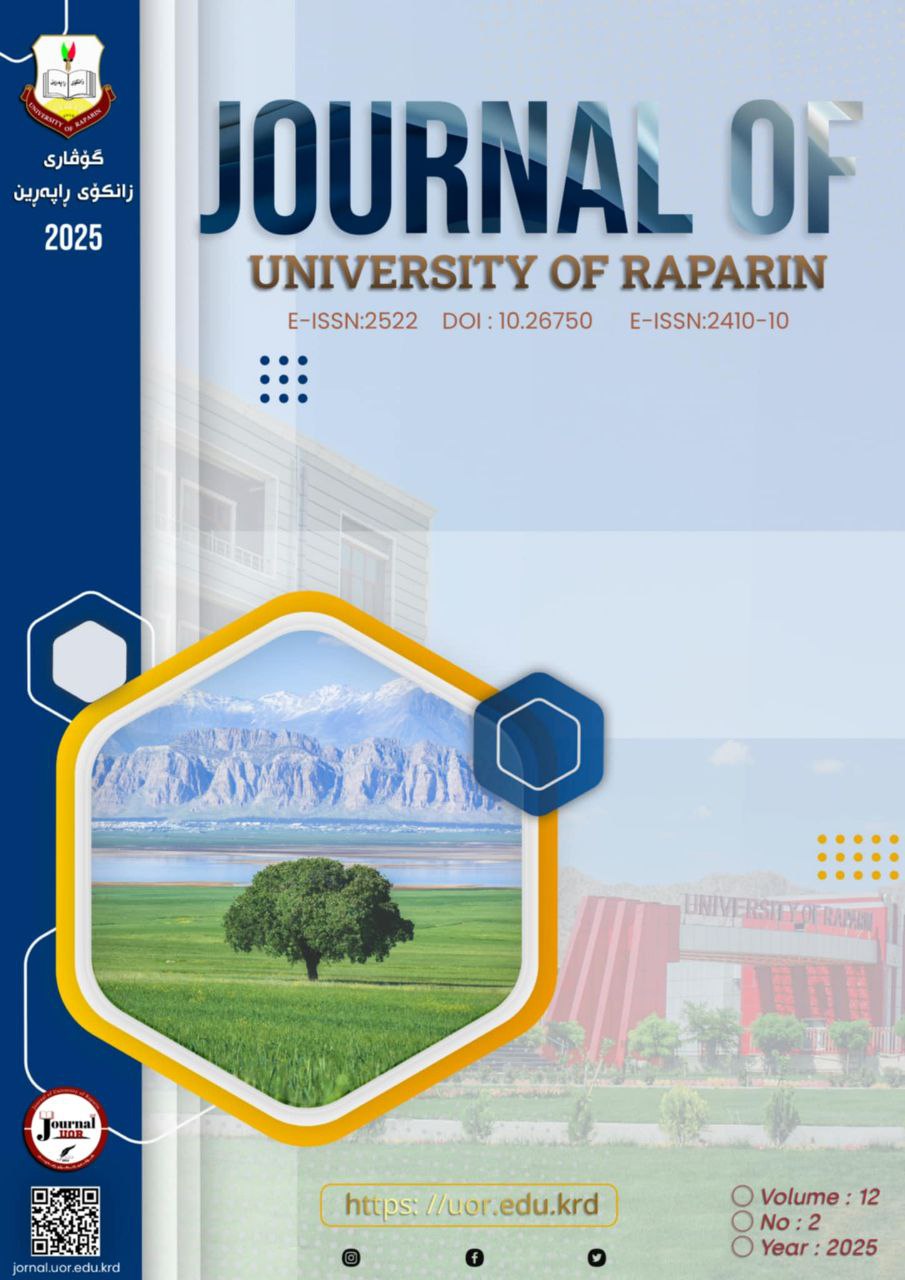الملخص
This study is devoted to framing of how to describe "Minimalist Program Related to Collocation in Kurdish Language", aiming to address and analyze the history, principles, the detail of the Program and its distinguished characteristics from the previous stages of Generative and Transformation Grammar, along with the specifying of the most significant modifications and transitions. Furthermore, it analysis the use of the Program in the correct syntactical representation of collocation, whereas up to date; Studies and researches on language and linguistics in Kurdistan has been regarded as a hobby. In other words, little systematic research has been conducted on collocation and its principles.
Based on the foregoing principles, this paper aims to examine and explore certain aspects of a new stage of Generative and Transformation Grammar, which is “Minimalist Program”, and how to apply it on collocation in Kurdish language.
The Research is conducted according to the (Descriptive Analysis) Approach in the light of Chomsky's production theory. And; the research components are derived from the Central Kurmanji- Slemani dialect. In order to achieve this scientific purpose, the research has been divided into three Chapters:
The First section focuses on "Some Theoretical Aspects and the map of Minimalist Program", and the Second section is dedicated to "Transitions and Some Principles of Minimalist Program", while the Third section which is the final section of this study, Collocation in the Framework of Minimalist Program practically has been explored.
In this research, the Introduction, the Results and the bibliography, along with this Abstract are presented in a very scientific order.
المراجع
ئەحمەد، بێستون حەسەن (٢٠١٢)، كۆمەڵەوشە و پێكەوەهاتن لە زمانی كوردیدا، چاپی یەکهەم، بەڕێوەبەرایەتیی چاپ و بڵاوكردنەوەی سلێمانی، چاپخانەی لەریا، سلێمانی.
ئەمین، وریا عومەر (٢٠١١)، پیتۆکەکانی زمانەوانی، چاپی یەکهەم، دەزگای چاپ و بڵاوکردنەوەی ئاراس، چاپخانەی ئاراس، هەولێر.
دزەیی، عەبدولواحید موشیر (٢٠١٣)، ڕستەسازی ڕۆنانکاری و گوێزانەوە، چاپی یەکهەم، لە بڵاوکراوەکانی ناوەندی ئاوێر بۆ چاپ و بڵاوکردنەوە، هەولێر.
ڕەسوڵ، سەڵاح حەوێز (٢٠١٣)، پڕەنسیپی ئابوریکردن لە زمانی کوردیدا ــ لە ڕوانگەی تیۆری دەسەڵات و بەستنەوە و بچوکترین پڕۆگرامدا، نامەی دکتۆرا، فاکەڵتیی پەروەردە، زانکۆی کۆیە، کۆیە.
عەزیز، عومەر ئەحمەد (٢٠٢٣)، تیۆری پاساودان لە زمانی کوردیدا، نامەی دکتۆرا، کۆلێژی پەروەردە، زانکۆی گەرمیان، کەلار.
عەزیز، عومەر ئەحمەد و قادر، صەباح ڕەشید (٢٠٢٣)، فرەدیاریکەریی لە زمانی کوردیدا (زاری ناوەڕاست)، گۆڤاری زانکۆی گەرمیان، Vol.10، No.2، زانکۆی گەرمیان، کەلار.
غەریب، کەمال جەلال (٢٠١٢)، پڕۆژەی زاراوەی زانستیی کوردی، چاپی دوهەم، دەزگای چاپ و بڵاوکردنەوەی ئاراس، چاپخانەی ئاراس، هەولێر.
سەعید، سازان زاهیر (٢٠١٩)، نواندنی سینتاکسیی لە زمانی کوردییدا، نامەی دکتۆرا، کۆلێژی زمان، زانکۆی سلێمانی، سلێمانی.
قادر، تارا موحسین (٢٠١١)، زمانی کوردیی و مینیماڵ پڕۆگرام، نامەی دکتۆرا، سکوڵی زمان، زانکۆی سلێمانی، سلێمانی.
قادر، سەباح ڕەشید (٢٠١٠)، تیۆری پاساودان (checking theory)، گۆڤاری ئەکادیمی ــ ئەکادیمیای کوردی، ژمارە (١٦)، لە بڵاوکراوەکانی ئەکادیمیای کوردی، چاپخانەی حاجی هاشم، هەولێر.
قادر، ڕەمەزان حەمەدەمین (٢٠٢٠)، تیۆرەکانی فێربون (جێبەجێکردنی پەروەردەیی)، چاپی یەکهەم، لە بڵاوکراوەکانی کتێبخانەی سۆفیا ــ کۆیە، چاپخانەی سایە، سلێمانی.
محەمەد، حاتەم ولیا (٢٠٠٩)، پەیوەندییە ڕۆنانییەکانی نواندنە سینتاکسییەکان لە زمانی کوردیدا، نامەی دکتۆرا، کۆلێژی زمان، زانکۆی سەڵاحەددین، هەولێر.
مەحویی، محەمەد، قادر، کاروان عومەر و حسێن، شیلان عومەر (٢٠١٠)، دروستەی کردار لە زمانی کوردییدا ــ بنەما و دیاردە، زانکۆی سلێمانی، سلێمانی.
مەعروف، عەبدولجەبار مستەفا (٢٠٢٠)، لێکۆڵینەوە لە فەرهەنگ و سینتاکسی کوردی، بەرگی یەکهەم، چاپی یەکهەم، چاپخانەی سارا، سلێمانی.
هەژار (١٣٦٩)، هەنبانەبۆرینە (فرهنگ کوردی ــ فارسی)، یک جلدی، چاپ اول، سروش، تهران.
سەعدوڵڵا، سەڵاح (١٩٩٨)، قاموسا (ئینگلیزی ــ کوردی(، چاپی یەکهەم، بێ چاپخانە؟ ، بێ شوێن؟.
عبدالحمید، حمد (٢٠٠٤)، البحث العلمی في الدراسات العالمية، الطبعة الثانية، عالم الكتب، القاهرة.
أبو عاصي، حمدان رضوان (٢٠٠٧)، التطورات النظرية و المنهجية للنظرية التوليدية في نصف قرن، مجلة جامعة الشارقة للعلوم الشرعية والإنسانية، مجلد (4) ، العدد (٣)، جامعة الشارقة.
Aarts, B. (2001). English Syntax and Argumentation. 2nd edition, Palgrave Macmillan.
Abdulrahman, N.S. (2007). Argument structure with reference to English and Kurdish MSc thesis. University of Dohuk: College of Arts.
Al-Halaby, S. N. (2000). Collocational Expressions in English and Arabic Translation. Unpublished M.A. thesis. University of Mosul: College of Arts.
Al-Mutairi, F.R., (2014). The minimalist program: The nature and plausibility of Chomsky's biolinguistics (Vol. 143). Cambridge: Cambridge University Press.
Boecky, C. (2006). Liguistic, Minimalism, Oxford: Oxford University Press.
Cambridge Dictionary. (2003). Cambridge Advanced Learner’s Dictionary. India: Thomson Press Limited.
Cedric, B. (2006). Linguistic Minimalism. UK: Oxford University Press.
Chomsky, N. (1995). Minimalism Investigation in Linguistic Theory. London: Routledge.
Collins, C. 2001. Economy conditions in syntax. in M. Baltin and C. Collins (eds.), The handbook of contemporary syntactic theory. Oxford: Blackwell, pp. 45-61.
Cook, V. J. & New son, M. L. (1997). Chomsky’s Universal Grammar. Oxford: Black Well.
Corver, N.and Nunes, J.eds (2007). The copy theory of movement (Vol. 107). John Benjamins Publishing, Amsterdam/ Philadelphia.
Crystal, D. (2003). A Dictionary of Linguistics & Phonetics. [5th ed.]. Oxford: Black Well.
Firth J. R. (1957). Modes of Meaning: Papers in linguistics: (1934-1951), London: Oxford University Press.
Epstein, S. & Seely T.D. (2002). Derivation and Explanation in the Minimalist Program, John Wiley & Sons, USA.
Hamasoor, S. A. (2006). A Syntactic and semantic study of collocation in English and Kurdish. University Of Sulamani: College Languages.
Heine, B. & Narrog, H. (2010). The Oxford Handbook of Linguistics Analysis, New York: Oxford University Press Inc.
Holmberg, A. (2000). The Role of Inflection in Scandinavian Syntax. Oxford University Press.
Longman Dictionary. (2003). Longman Dictionary of Contemporary English. UK: Pearson Education Limited.
Neelman, A. Philip, J. Tanaka, M. & De Koot, H. (2022). Syntactic Asymmetry and Binary Branching, University collage of London.
Palmer, F. R. (1976). Semantics. A New Outline. Great Britain: Cambridge University Press.
Van Valin jr. R. D. (2001). An Introduction to syntax. Cambridge: Great Britain: Cambridge University Press.
Radford, A. (2004). English Syntax An Introductio. United Kingdom: Cambridge University Press.
Wouden, T. V. (1997). Negative Contexts: Collocation, Polarity, and Multiple Negation, London: Routledge.

هذا العمل مرخص بموجب Creative Commons Attribution-NonCommercial-NoDerivatives 4.0 International License.
الحقوق الفكرية (c) 2025 Journal of University of Raparin

